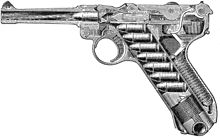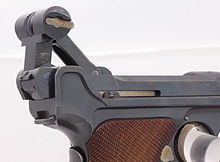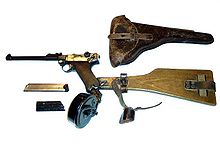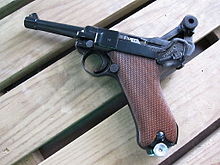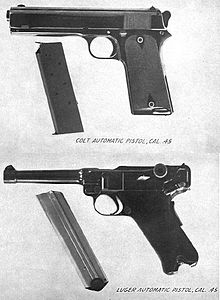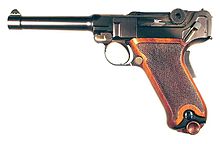- Luger P08 pistol
-
This article is about the Luger pistol. For other meanings of parabellum, see Parabellum (disambiguation).
Luger P08 (Parabellum) 
P08 of the German ReichsmarineType Semi-automatic pistol Place of origin  German Empire
German EmpireService history In service Germany (1908–1945)
Switzerland (1900–early 70s)
Other countries (1900–present)Used by See Users Wars World War I, Spanish Civil War, World War II, Second Sino-Japanese War, Chinese Civil War, Others Production history Designer Georg J. Luger Manufacturer Deutsche Waffen und Munitionsfabriken, Imperial Arsenals of Erfurt and Spandau, Simson, Krieghoff, Mauser, Vickers, Waffenfabrick Bern Produced 1900–1945 Specifications Weight 1.92 lbs (871 grams) Length 8.75 in (222 mm) Barrel length 98-203 mm
(3.9-8.02 in)Cartridge 7.65×21mm Parabellum
9×19mm Parabellum
.45 ACPAction Toggle-locked, short recoil Rate of fire Semi-automatic Muzzle velocity 350-400 m/s or 1148-1312 f/s (9 mm, 4-inch barrel) Effective range 50 m (9 mm, 4 inch barrel; short barrel) Feed system 8-round detachable box magazine, 32-round detachable drum Sights Iron sights The Pistole Parabellum 1908 or Parabellum-Pistole (Pistol Parabellum), popularly[1] known as the Luger, is a toggle-locked recoil-operated semi-automatic pistol. The design was patented by Georg J. Luger in 1898 and produced by German arms manufacturer Deutsche Waffen- und Munitionsfabriken (DWM) starting in 1900; it was an evolution of the 1893 Hugo Borchardt designed C-93. It would be succeeded and partly replaced by the Walther P38.
The Luger was made popular by its use by Germany during World War I and World War II. Although the Luger pistol was first introduced in 7.65×21mm Parabellum, it is notable for being the pistol for which the 9×19mm Parabellum (also known as the 9 mm Luger) cartridge was developed.
Contents
Design details
The Luger uses a toggle-lock action, which uses a jointed arm to lock, as opposed to the slide actions of almost every other semi-automatic pistol. After a round is fired, the barrel and toggle assembly (both locked together at this point) travel rearward due to recoil. After moving roughly 0.5 in (13 mm) rearward, the toggle strikes a cam built into the frame, causing the knee joint to hinge and the toggle and breech assembly to unlock. At this point the barrel impacts the frame and stops its rearward movement, but the toggle and breech assembly continue moving (bending the knee joint) due to momentum, extracting the spent casing from the chamber and ejecting it. The toggle and breech assembly subsequently travel forward under spring tension and the next round from the magazine is loaded into the chamber. The entire sequence occurs in a fraction of a second. This mechanism works well for higher pressure cartridges, but cartridges loaded to a lower pressure can cause the pistol to malfunction because they do not generate enough recoil to work the action fully. This results in either the breech block not clearing the top cartridge of the magazine, or becoming jammed open on the cartridge's base.[2]
In World War I, as submachine guns were found to be effective in trench warfare, experiments with converting various types of pistols to machine pistols (Reihenfeuerpistolen, literally "row-fire pistols" or "consecutive fire pistols") were conducted. Among those the Luger pistol (German Army designation Pistole 08) was examined; however, unlike the Mauser C96, which was later manufactured in a selective-fire version (Schnellfeuer) or Reihenfeuerpistolen, the Luger proved to have an excessive rate of fire in full-automatic mode.
The Luger pistol was manufactured to exacting standards and had a long service life. William "Bill" Ruger praised the Luger's 55 degree grip angle and duplicated it in his .22 LR pistol.
Service
The Swiss Army evaluated the Luger pistol in 7.65×21mm Parabellum (.30 Luger in North America) and adopted it in 1900 as its standard side arm, designated Ordonnanzpistole 00 or OP00, in 1900. This model uses a 120 mm barrel.
The Luger pistol was accepted by the German Navy in 1904. The Navy model had a 150 mm barrel and a two position (100/200 metre) rear sight. This version is known as Pistole 04.
In 1908 the German Army adopted the Luger to replace the Reichsrevolver in front-line service. The Pistole 08 (or P.08) had a 100 mm barrel and was chambered in 9×19mm Parabellum. The P.08 was the usual side arm for German Army personnel in both world wars, though it was being replaced by the Walther P38 starting in 1938. In 1930, Mauser took over manufacture of the P.08 (until 1943).[3]
The Lange Pistole 08 (German: "Long Pistol 08") or Artillery Luger was a pistol carbine for use by German Army artillerymen as a sort of early Personal Defense Weapon. It had a 200 mm barrel, an 8-position tangent rear sight (calibrated to 800 metres) and a shoulder stock with holster. It was sometimes used with a 32-round drum magazine (Trommelmagazin 08). It was also available in various carbine versions with yet longer barrels.
The firm Armeria Belga of Santiago Chile, manufactured the Benke Thiemann retractable stock that could fold out from the grip section.
The United States evaluated several semi-automatic pistols in the late 19th century, including the Colt M1900, Steyr Mannlicher M1894, and an entry from Mauser. In 1900 the US purchased 1000 7.65 mm Lugers for field trials. Later, a small number were sampled in the then-new, more powerful 9 mm round. Field experience with .38 caliber revolvers in the Philippines and ballistic tests would result in a requirement for still-larger rounds.
In 1906 and 1907, the US Army held trials for a large-caliber semi-automatic. DWM provided two sample Luger pistols chambered in .45 ACP for testing, but neither is known to have survived. At least two pistols were manufactured later for possible commercial or military sales, and one is exhibited at the Norton Gallery, in Shreveport, Louisiana. The other was sold in 2010 and remains in a private collection. After initial trials, DWM, Savage, and Colt were asked to provide further samples for evaluation. DWM withdrew for reasons that are still debated, though the Army did place an order for 200 more samples.
Usage today
Although outdated, the Luger is still sought after by collectors both for its sleek design and accuracy, and for its connection to Imperial and Nazi Germany. Limited production of the P.08 by its original manufacturer resumed when Mauser refurbished a quantity of them in 1999 for the pistol's centenary. More recently, Krieghoff announced[4] the continuation of its Parabellum Model 08 line with 200 examples at $17,545.00 apiece. The Luger was prized by Allied soldiers during both of the World Wars. Thousands were taken home during both wars, and are still in circulation today. Colonel David Hackworth mentions in his autobiography that it was still a sought-after sidearm in the Vietnam War. Recently the first serious study on the Post World War II Luger has been published (The Parabellum is Back! 1945 - 2000); it covers the Luger production from 1945 until 2000. In fact, in 1945 Mauser set up again the Luger production under the control of the French forces. In 1969, Mauser Werke in Oberndorf restarted the production until 1986 when the last commemorative model was produced.[5]
Users
Bibliography
- Imperial Lugers by Jan C. Still (Still's Books, 1994)
- Third Reich Lugers by Jan C. Still (Still's Books, 1988)
- Weimar Lugers by Jan C. Still (Still's Books, 1993)
- Lugers at Random by Charles Kenyon (Hand Gun Press, 1990)
- La Luger Artiglieria by Mauro Baudino (Editoriale Olimpia, 2004)
- Luger Mechanical Features by Gerard Henrotin (HLebooks – 2002)
- The Luger Models by Gerard Henrotin (HLebooks – 2001)
- The Luger Producers by Gerard Henrotin (HLebooks – 2001)
- Luger Accessories by Gerard Henrotin (HLebooks – 2003)
- DWM Luger by Gerard Henrotin (HLebooks – 2001)
- The Parabellum is Back! 1945 - 2000 by Mauro Baudino and Gerben van Vlimmeren (Simpson Ltd - 2010)
- The Mauser Parabellum 1930-1946 - Analysis of a Million Luger Pistols by Don R. Hallock & Joop van den Kant (HaKa Arms Publications C0 - 2010)
See also
References
- ^ Fitzsimons, Bernard, ed. The Illustrated Encyclopedia of Weapons and Warfare (London: Phoebus, 1977), Volume 16, p.1778, "Luger".
- ^ Hogg, Ian & Weeks, John. "Military Small Arms of the 20th Century". Krause Publications. (2000) ISBN 0-87341-824-7
- ^ Fitzsimons, p.1778.
- ^ http://www.krieghoff.com/content/view/176/145/
- ^ Bishop, Chris (1998). The Encyclopedia of Weapons of World War II. New York: Orbis Publiishing Ltd. ISBN 0-7607-1022-8.
- ^ Walter, John. The Luger Story. Greenhill Books. p. 127. ISBN 1853674362.
- ^ Miller, David. Fighting Men of World War II, Volume I: Axis Forces--Uniforms, Equipment, and Weapons (Fighting Men of World War II). Stackpole Books. p. 369. ISBN 0811702774.
- ^ a b Davis, Aaron (2006). Standard Catalog of Luger. Gun Digest Books; 2 edition ISBN 0896894118
- ^ Miller, David (2001). The Illustrated Directory of 20th Century Guns. Salamander Books Ltd. ISBN 1-84065-245-4.
- ^ a b c Bishop, Chris, ed (2002). The Encyclopedia of Weapons of World War II. Metrobooks. p. 228. ISBN 1586637622. http://books.google.com/?id=MuGsf0psjvcC&pg=PA228. Retrieved 2010-03-02.
- ^ Armamento do Exército Português, Vol.I - Armamento Ligeiro, António José Telo, Mário Álvares, 2004, p. 100 to 103, ISBN 972-8816-43-X
External links
- The Million Dollar Luger
- The Borchardt-Luger History - origins of the Parabellum
- Luger Artillery and Mauser Parabellum
- Luger 08 in parts
- Modern Firearms
- Bulgarian Luger 08 on GunsTribune
- The history of the Luger pistol from 1945 until 2000
- A Luger-related searchable database with hundreds of photos and values
German firearms and light weapons of World War IISide arms (Pistolen) Mauser C96 · Luger · Walther P38 · Walther PP and PPK · Sauer 38H · Mauser HSc · Dreyse M1907 Pistol · VolkspistoleRifles & carbines (Gewehre & Karabiner) Karabiner 98k · G 24(t) · G 33/40(t) · G 98/40 · Gewehr 41 · Gewehr 43/Karabiner 43 · MP 43/MP 44/StG 44 · FG 42 · M30 Luftwaffe drilling · StG 45(M) · VG 1-5 · Wimmersperg Spz-krSubmachine guns (Maschinenpistolen) Machine guns & other larger weapons MG 08 · VMG-27 · Schwarzlose MG M.07/12 · MG 13 · MG 15 · MG 26 · MG 30 · MG 34 · MG 42 · MG 45 · IMG 28 · MG 35/36A · Faustpatrone · Raketen-Panzerbüchse 43 · Panzerfaust · Panzerschreck · Fliegerfaust/Luftfaust · Flammenwerfer 35 · Einstossflammenwerfer 46 · Panzerbüchse 39 · Solothurn S-18/1000Mortars (Granatwerfer) Grenades (Granaten) Notable foreign-made infantry weapons German-made cartridges used by the Wehrmacht 8×57mm IS · 7.63×25mm Mauser · 8x33mm Kurz · 7.65×22mm Parabellum · 9×19mm Parabellum · 13.2×92mmSR · 7.92×94mmCategories:- 1900 introductions
- Semi-automatic pistols
- Early semi-automatic pistols
- German guns
- German semi-automatic pistols
- World War I German infantry weapons
- World War II German infantry weapons
- 7.65mm firearms
- 9mm Parabellum firearms
- Curio and relic firearms
Wikimedia Foundation. 2010.

